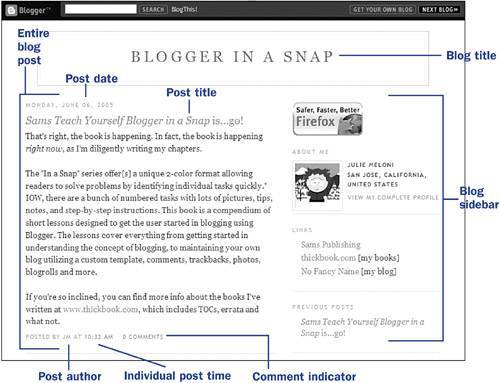Understanding the Anatomy of a Blog
| Unlike websites, which can be unpredictable with regards to content and structure, blogs tend to have very distinct elements that follow a typical order. That is, blogs contain posts, which might or might not allow for comments, and these posts are displayed with the most recent post at the beginning of the index page. Additionally, blog templates are often put together so that the display contains a sidebar column into which the blog author can put lists of links, affiliations, and other information pertinent to the author or his blog. A typical blog template.  The figure shown here displays some of the typical elements you will see in a blog. Although the physical styles of blog templatescolors, fonts, and so forthoften differ between users, general structural elements remain consistent. For instance, all blogs have a title that is displayed prominently at the top of the blog main page as well as subsequent blog archive pages. A day's worth of blog posts will begin with the posting date, followed by the title of the individual post. The content of the post comes next, and the posting time comes at the end. In the footer area of the post, where the posting time is usually displayed, you might also see the post author's name, something like posted by [yourname]. The inclusion of the post author's name is important when posting to a group blog because readers will want to know exactly which member of the group blog posted this particular bit of content. If multiple blog entries are posted on the same day, as shown in this example, each entry will fall under the single posting date heading, with the most recent post listed at the top. As with all elements of display, the appearance of blog comments is customizable. When using Blogger's built-in commenting system, you may choose to enable or disable comments for your entire blog or just particular posts. Some times you might write posts that don't necessarily warrant comments, or just might not feel like opening comments for very personal posts. You'll learn more about the customization of Blogger comments, as well as third-party commenting systems, in Chapter 6, "Commenting and Trackback." The final element shown in this example is the sidebar. Blog templates, especially the stock Blogger templates, almost always have a side column built into them, for the placement of author information, blogrolls, and other links of interest to the author. Some people use this area to personalize their blog; in addition to the basic "about me" information, you might see dynamic images that reflect the author's mood, a list of songs the author is listening to, or a list of books and movies that the author has recently enjoyed. Placing elements in the sidebar is part of editing the Blogger template itself, which you will learn about in Chapter 5, "Working with Blogger Templates." Remaining AnonymousYou will likely encounter more pseudonymous bloggers than those who use their real names and tell you their actual geographic location. Such a blogger will often go to great lengths to protect her identity and location. You will often see pseudonyms for institutions and other locations, such as the following description from a pseudonymous academic blogger: "BrightStar is the alias of an assistant professor making her way on the tenure track. She is entering her second year on the faculty at Research University (RU) in Sleepy Town." So, throughout all the posts made by this blogger, the town in which she lives is always referenced as "Sleepy Town" and her place of employment as "RU." Never will she say "here in Smithville" or "in the Geography Department at Northeast State Technical College" because such specifics would enable readers to discern her identity. Similarly, as this blogger leaves comments on other sites, she uses her alias instead of her real name. Additionally, as seen in this example, some pseudonymous bloggers use a graphical image, called an avatar, to represent them online. The blog of a pseudonymous blogger.  The reasons for using a pseudonym are unique for every blogger. Some people want the freedom to write whatever they want without having to worry that their friends, family, employers, and co-workers will find some scathing remarks via a Google search.
http://www.dooce.com Heather Armstrong is a blogger who was fired for items posted on her blog. Her blog is (and was at the time) called Dooce, which lead to creation of the slang verb dooce, meaning "to be fired from your job for items posted on your blog." Heather is not the only person ever to be fired for blogging about her job or on the job. Read your employee handbook and use good sense if you're using real names. For others, the reasons for using a pseudonym have to do with privacy and personal safetyespecially when it comes to families and children. If a blogger writes about daily life and daily routines without having a masked identity, it is possible that some of the less savory individuals in this world would take advantage of these movements. Still others might simply want to create a different persona for their life online, different than the persona that is assumed by using a real name and personal or professional description. Some of the issues described earlier might also play into the decision to remain pseudonymous, or the blogger might simply want to carve out a new niche. |
EAN: 2147483647
Pages: 124
 DOOCE
DOOCE